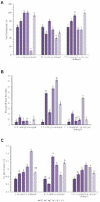Endophytic Bacillus subtilis antagonize soil-borne fungal pathogens and suppress wilt complex disease in chickpea plants (Cicer arietinum L.)
- PMID: 36406422
- PMCID: PMC9667066
- DOI: 10.3389/fmicb.2022.994847
Endophytic Bacillus subtilis antagonize soil-borne fungal pathogens and suppress wilt complex disease in chickpea plants (Cicer arietinum L.)
Abstract
The present study aimed to identify potential endophytic bacteria antagonistic against three soil-borne fungal pathogens, Rhizoctonia solani, Sclerotium rolfsii, and Fusarium oxysporum f.sp. ciceri causing root rot, collar rot, and fungal wilt diseases in chickpea plants, respectively. A total of 255 bacterial endophytes were isolated from the leaves, stems, and roots of seven different crop plants (chickpea, tomato, wheat, berseem, mustard, potato, and green pea). The dual culture-based screening for antifungal properties indicated that three endophytic isolates had strong inhibition (>50%) against all three pathogens tested. Based on morphological, biochemical, and molecular characterization, the selected isolates (TRO4, CLO5, and PLO3) were identified as different strains of Bacillus subtilis. The bacterial endophytes (TRO4 and CLO5) were positive for plant growth promoting (PGP) traits viz., ammonia, siderophore, and indole-3-acetic acid (IAA) production. The bio-efficacy of the endophytes (TRO4, CLO5, and PLO3) was tested by an in planta trial in chickpea pre-challenged with R. solani, S. rolfsii, and F. oxysporum f.sp. ciceri. The B. subtilis strains TRO4 and CLO5 were found to be effective in reducing percent disease incidence (p ≤ 0.05) and enhancing plant growth parameters. The different root parameters viz. root length (mm), surface area (cm2), root diameter (mm), and root volume (cm3) were significantly (p ≤ 0.05) increased in TRO4 and CLO5 inoculated chickpea plants. Confocal Scanning Laser Microscopy showed heavy colonization of bacteria in the roots of endophyte-inoculated chickpea plants. The inoculation of endophytic Bacillus subtilis strains TRO4 and CLO5 in chickpea plants through seed biopriming reduced the accumulation of superoxide, enhanced the plant defense enzymes, and induced the expression of Pathogenesis-Related (PR) genes. Semi-quantitative analysis of defense-related genes showed differential activation of PR genes (60srp and IFR) by endophyte inoculation. The results of the present study reveal the antagonistic potential of B. subtilis strains TRO4 and CLO5 against three major soil-borne fungal pathogens and their ability to suppress wilt complex disease in chickpea plants. This is the first report on the simultaneous suppression of three major soil-borne fungal pathogens causing wilt complex in chickpea plants by endophytic B. subtilis strains.
Keywords: Bacillus subtilis; ISR; antagonism; bacterial endophytes; chickpea (Cicer arietinum L.); fungal pathogens; seed biopriming; wilt complex.
Copyright © 2022 Mageshwaran, Gupta, Singh, Sahu, Singh, Chakdar, Bagul, Paul and Singh.
Conflict of interest statement
The authors declare that the research was conducted in the absence of any commercial or financial relationships that could be construed as a potential conflict of interest.
Figures








Similar articles
-
Harnessing chickpea bacterial endophytes for improved plant health and fitness.AIMS Microbiol. 2024 Jul 8;10(3):489-506. doi: 10.3934/microbiol.2024024. eCollection 2024. AIMS Microbiol. 2024. PMID: 39219751 Free PMC article. Review.
-
Endophytic Bacteria Improve Plant Growth, Symbiotic Performance of Chickpea (Cicer arietinum L.) and Induce Suppression of Root Rot Caused by Fusarium solani under Salt Stress.Front Microbiol. 2017 Sep 28;8:1887. doi: 10.3389/fmicb.2017.01887. eCollection 2017. Front Microbiol. 2017. PMID: 29033922 Free PMC article.
-
Harnessing chickpea (Cicer arietinum L.) seed endophytes for enhancing plant growth attributes and bio-controlling against Fusarium sp.Microbiol Res. 2020 Aug;237:126469. doi: 10.1016/j.micres.2020.126469. Epub 2020 Mar 19. Microbiol Res. 2020. PMID: 32251977
-
Exploring biocontrol and growth-promoting potential of multifaceted PGPR isolated from natural suppressive soil against the causal agent of chickpea wilt.Microbiol Res. 2022 Jul;260:127015. doi: 10.1016/j.micres.2022.127015. Epub 2022 Mar 27. Microbiol Res. 2022. PMID: 35447486
-
Biocontrol by Fusarium oxysporum Using Endophyte-Mediated Resistance.Front Plant Sci. 2020 Feb 6;11:37. doi: 10.3389/fpls.2020.00037. eCollection 2020. Front Plant Sci. 2020. PMID: 32117376 Free PMC article. Review.
Cited by
-
Screening of Reference Genes under Biotic Stress and Hormone Treatment of Mung Bean (Vigna radiata) by Quantitative Real-Time PCR.Genes (Basel). 2023 Aug 30;14(9):1739. doi: 10.3390/genes14091739. Genes (Basel). 2023. PMID: 37761879 Free PMC article.
-
Antagonistic Strain Bacillus halotolerans Jk-25 Mediates the Biocontrol of Wheat Common Root Rot Caused by Bipolaris sorokiniana.Plants (Basel). 2023 Feb 13;12(4):828. doi: 10.3390/plants12040828. Plants (Basel). 2023. PMID: 36840176 Free PMC article.
-
Harnessing chickpea bacterial endophytes for improved plant health and fitness.AIMS Microbiol. 2024 Jul 8;10(3):489-506. doi: 10.3934/microbiol.2024024. eCollection 2024. AIMS Microbiol. 2024. PMID: 39219751 Free PMC article. Review.
-
Seasonal changes in the abundance Fusarium proliferatium, microbial endophytes and nutrient levels in the roots of hybrid bamboo Bambusa pervariabilis × Dendrocalamopsis grandis.Front Plant Sci. 2023 Jul 19;14:1185449. doi: 10.3389/fpls.2023.1185449. eCollection 2023. Front Plant Sci. 2023. PMID: 37538062 Free PMC article.
-
Nutrient-Driven Metabolic Activation and Microbial Restructuring Induced by Endophytic Bacillus in Blight-Affected Forest Soils.Microorganisms. 2025 Jun 23;13(7):1454. doi: 10.3390/microorganisms13071454. Microorganisms. 2025. PMID: 40731964 Free PMC article.
References
-
- Agrios G.N. (2005). Plant Pathology, 5th Edn, Amsterdam: Elsevier Academic Press.
-
- Anderson N. A. (1982). The genetics and pathology of Rhizoctonia solani. Annu. Rev. Phytopathol. 20, 329–347. doi: 10.1146/annurev.py.20.090182.001553 - DOI
-
- Aycock R. (1966). Stem rot and other diseases caused by Sclerotium rolfsii. NC Agric. Exp. Stn. Tech. Bull. 174:202.
-
- Bacon C.W., White J.F. (2000). Microbial Endophytes. Published by Marcel Decker Inc., New York, USA
-
- Bekkar A. A., Zaim S., Belabid L. (2018). Induction of systemic resistance in chickpea against Fusarium wilt by Bacillus strains. Arch. Phytopathol. Pflanzenschutz. doi: 10.1080/03235408.2018.1438819 - DOI
LinkOut - more resources
Full Text Sources
Research Materials
Miscellaneous

